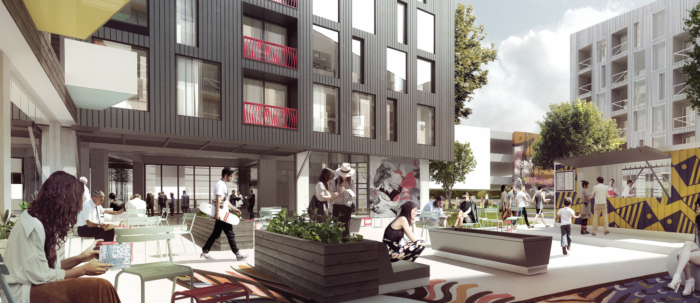More recently, Gravity, a $70 million experiment overseen by Kaufman Development, is making headlines with its promises of a space that will inspire creativity and create special bonds between individuals and the neighborhood.
Located at 500 W. Broad St., four Gravity wings will incorporate 236 residential apartments, 50,000 square feet of offices, and 30,000 square feet reserved for shops and restaurants. Gravity will also serve as a hub for a variety of activities such as meditation sessions, food festivals, and guest speaker lectures.
The first residents are scheduled to move in this spring, and major corporations including Bark and Pelotonia have signed on to lease office space.
“Live, work, and play,” a term used by developers to describe mixed-use real estate such as Gravity, is not, however, a new concept.
In fact, it could be argued that the concept dates back hundreds of thousands of years ago to the first cavemen and their elaborate cave systems. The ancient city of Pompeii also heavily utilized mixed-use developments in that important places could all be accessed within a walking distance. Work and commerce only separated from homes during the industrial revolution when machinery began to require large spaces and a concentrated labor force.
So why then, are mixed-use developments making a comeback? One plausible explanation: sustainability.
In recent years, sustainability has become more critical as the world population continues to grow exponentially and with it, public unease regarding the implications on the environment. With research showing that mixed-use developments are more practical economically and land efficient, many cities, including Columbus, have been jumping on the trend.
Additionally, Lee Ritchie, a Re/Max Metro Plus realtor, says, “Millennials and baby boomers all seem to want to live in an urban environment,” accelerating the demand for the developments.
Mixed-use developments are appearing not just in Franklinton, but near Polaris Fashion Place, Easton Town Center, and in Dublin’s new Bridge Park District.
As Gravity and its counterparts rise, concern regarding gentrification have alos become a concern.
On the topic of why Franklinton was chosen as the location for Gravity, Brett Kaufman, CEO of Kaufman Development, said, “We felt connected to the unique, creative class of people down there focused around the arts and felt we could do something unique in the city.” And in attempt to stay true to Franklinton’s rich artistic history, project designers decided that Gravity’s interior and exterior walls would be painted by over 20 artists, including renowned muralist, Eduardo Kobra of Brazil.
But the sad irony here is that Gravity may be pushing the artist population out of Franklinton. Just look at the upshot in rent hikes: in November of 2016, the average price for a single family home in Franklinton was $21,000. Today, in January of 2019, the average price has shot up to $53,000.
Although Gravity as well as other nearby developments may have caused a swift increase in Franklinton’s property prices, there is reason to believe that the developers are seeking to strike a balance. Residents have been able to voice their opinions at meetings with the Franklinton Area Commission and the East Franklinton Review Board, and the developers have been accommodating.
Most if not all of the new residential developments in Franklinton have agreed to reserve 20 percent of their units for “workforce housing” and lower costs for residents who meet a certain federal financial criteria. Gravity’s units in particular, range from 416 to 1,174 square feet, with costs beginning at $835 a month.
Gravity seems to provide an affordable housing option considering that in 2018, Chris Tennant, a Franklinton resident and artist, said, “Rents are typically $800 to $1,000 a month for studios. If anything, it’s all having a good effect with people coming to the neighborhood and spending money.”
With an influx of businesses due to the new mixed-use developments, Franklinton residents will see a swell of job opportunities, and some have expressed their hopes for a decrease in crime.
In the next couple of years, it is expected that we will see more and more similar projects to Gravity. As it happens, Gravity 2.0 is already in the works.








